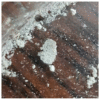Biosynthesis of Polyhydroxyalkanoates (PHAs) by the Valorization of Biomass and Synthetic Waste
- PMID: 33255864
- PMCID: PMC7728366
- DOI: 10.3390/molecules25235539
Biosynthesis of Polyhydroxyalkanoates (PHAs) by the Valorization of Biomass and Synthetic Waste
Abstract
Synthetic pollutants are a looming threat to the entire ecosystem, including wildlife, the environment, and human health. Polyhydroxyalkanoates (PHAs) are natural biodegradable microbial polymers with a promising potential to replace synthetic plastics. This research is focused on devising a sustainable approach to produce PHAs by a new microbial strain using untreated synthetic plastics and lignocellulosic biomass. For experiments, 47 soil samples and 18 effluent samples were collected from various areas of Punjab, Pakistan. The samples were primarily screened for PHA detection on agar medium containing Nile blue A stain. The PHA positive bacterial isolates showed prominent orange-yellow fluorescence on irradiation with UV light. They were further screened for PHA estimation by submerged fermentation in the culture broth. Bacterial isolate 16a produced maximum PHA and was identified by 16S rRNA sequencing. It was identified as Stenotrophomonas maltophilia HA-16 (MN240936), reported first time for PHA production. Basic fermentation parameters, such as incubation time, temperature, and pH were optimized for PHA production. Wood chips, cardboard cutouts, plastic bottle cutouts, shredded polystyrene cups, and plastic bags were optimized as alternative sustainable carbon sources for the production of PHAs. A vital finding of this study was the yield obtained by using plastic bags, i.e., 68.24 ± 0.27%. The effective use of plastic and lignocellulosic waste in the cultivation medium for the microbial production of PHA by a novel bacterial strain is discussed in the current study.
Keywords: bacterial bioplastic; biodegradation; biological materials; biomass valorization; biomaterials; bioplastic; biopolymer; eco-friendly materials; microbial polymers; plastic bag.
Conflict of interest statement
The authors declare no conflict of interest.
Figures










Similar articles
-
The General Composition of Polyhydroxyalkanoates and Factors that Influence their Production and Biosynthesis.Curr Pharm Des. 2023;29(39):3089-3102. doi: 10.2174/0113816128263175231102061920. Curr Pharm Des. 2023. PMID: 38099526 Review.
-
A shortcut to carbon-neutral bioplastic production: Recent advances in microbial production of polyhydroxyalkanoates from C1 resources.Int J Biol Macromol. 2021 Dec 1;192:978-998. doi: 10.1016/j.ijbiomac.2021.10.066. Epub 2021 Oct 15. Int J Biol Macromol. 2021. PMID: 34656544 Review.
-
Superlative short chain length and medium chain length polyhydroxyalkanoates microbial producers isolated from Malaysian environment.Arch Microbiol. 2025 Feb 27;207(4):72. doi: 10.1007/s00203-025-04256-9. Arch Microbiol. 2025. PMID: 40014079 Review.
-
Production and characterization of polyhydroxyalkanoates from industrial waste using soil bacterial isolates.Braz J Microbiol. 2021 Jun;52(2):715-726. doi: 10.1007/s42770-021-00452-z. Epub 2021 Feb 15. Braz J Microbiol. 2021. PMID: 33590449 Free PMC article.
-
Effect of nutritional supplements on bio-plastics (PHB) production utilizing sugar refinery waste with potential application in food packaging.Prep Biochem Biotechnol. 2019;49(6):567-577. doi: 10.1080/10826068.2019.1591982. Epub 2019 Mar 31. Prep Biochem Biotechnol. 2019. PMID: 30929621
Cited by
-
Production of polyhydroxyalkanoates (PHAs) by Bacillus megaterium using food waste acidogenic fermentation-derived volatile fatty acids.Bioengineered. 2021 Dec;12(1):2480-2498. doi: 10.1080/21655979.2021.1935524. Bioengineered. 2021. PMID: 34115556 Free PMC article.
-
Biodegradable Polymers: Properties, Applications, and Environmental Impact.Polymers (Basel). 2025 Jul 18;17(14):1981. doi: 10.3390/polym17141981. Polymers (Basel). 2025. PMID: 40732859 Free PMC article. Review.
-
PHB production by Bacillus megaterium strain MNSH1-9K-1 using low-cost media.Braz J Microbiol. 2024 Mar;55(1):245-254. doi: 10.1007/s42770-023-01232-7. Epub 2024 Jan 12. Braz J Microbiol. 2024. PMID: 38212508 Free PMC article.
-
Versatility of Stenotrophomonas maltophilia: Ecological roles of RND efflux pumps.Heliyon. 2023 Mar 28;9(4):e14639. doi: 10.1016/j.heliyon.2023.e14639. eCollection 2023 Apr. Heliyon. 2023. PMID: 37089375 Free PMC article. Review.
-
Formulation of biogenic fluorescent pigmented PHB nanoparticles from Rhodanobacter sp. for drug delivery.Antonie Van Leeuwenhoek. 2024 May 3;117(1):75. doi: 10.1007/s10482-024-01973-x. Antonie Van Leeuwenhoek. 2024. PMID: 38700529
References
-
- Global Plastics & Rubber Products Manufacturing Report. [(accessed on 1 September 2020)]; Available online: https://www.thebusinessresearchcompany.com/report/plastics-and-rubber-pr....
-
- Grand View Research Inc. Plastics Market Size, Share & Trends Analysis Report By Product (PE, PP, PU, PVC, PET, Polystyrene, ABS, PBT, PPO, Epoxy Polymers, LCP, PC, Polyamide), By Application, and Segment Forecasts, 2019–2025. Grand View Research Inc.; 2019. [(accessed on 11 January 2020)]. 200p. Available online: https://www.grandviewresearch.com/industry-analysis/global-plastics-market.
-
- Ecommerce Gateway Pakistan. Pakistan—The Regional Business Hub. Plastic, Packaging & Print Asia; Proceedings of the 12th Plastic Machinery Technology Show, Karachi, Islamabad, and Lahore: Plastic, Packaging & Print Asia Secretariat; Karachi, Pakistan. 12–14 September 2020; Karachi, Pakistan: E-commerce Gateway; 2020.
-
- Plastic Pollution. [(accessed on 2 February 2020)]; Available online: https://coastalcare.org/2009/11/plastic-pollution/
MeSH terms
Substances
LinkOut - more resources
Full Text Sources
Molecular Biology Databases

